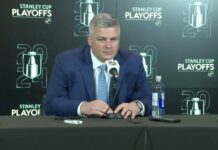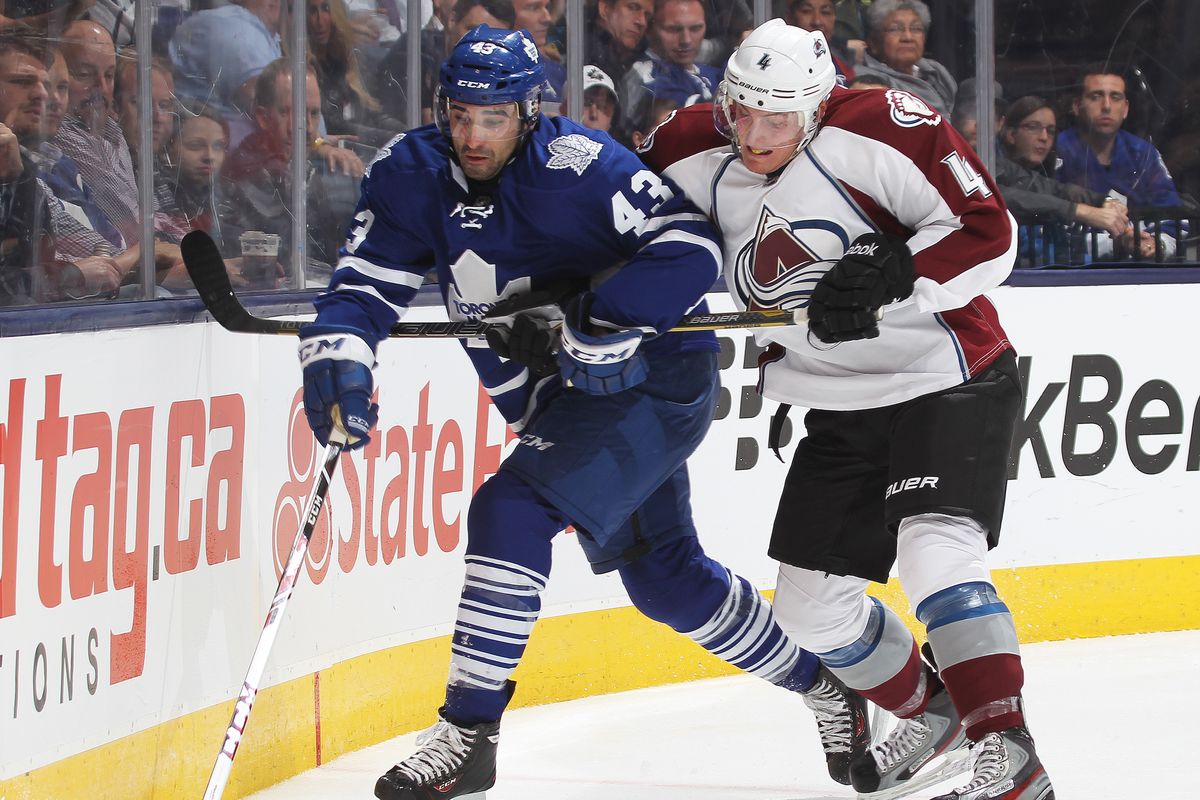There was something that occurred to me as I was taking stock of all of the Toronto Maple Leafs’ moves over the last week.
I don’t think they’re a significantly more talented team than they were before. That is not to say I’m down on the work Kyle Dubas has done, which has been substantial and transformative inside the span of two weeks, from offloading the two worst contracts on the team to scouring the FA bargain bin to pulling the trigger on the biggest blockbuster of his managerial tenure to date. But allow me to undertake a simplistic, opinionated bit of analysis for a second.
For me, while it had clear and understandable cap motives, Cody Ceci is a small downgrade on Nikita Zaitsev — their offensive games are close and Zaitsev is less of a mess defensively. I’m not saying the Leafs won’t be able to situate Ceci better in Toronto, and maybe Jake Muzzin can do for Ceci what he did for Zaitsev in the playoffs, but Zaitsev got by defensively against top competition better here in Toronto than Ceci showed in Ottawa.
The combination of Kerfoot and Spezza is not a clear upgrade on Kadri and Brown. The gap between Brown and Kerfoot is significant, but so is the one between Kadri and Spezza — not just in terms of age, skating ability and production, but the elements Kadri brought that are so lacking elsewhere on the roster (grit, a bit of screw-loose-y-ness).
Barrie is even more dynamic and productive than Jake Gardiner and owns a better shot, and is a significantly better power play threat, although he’s not a major upgrade at 5v5 when considering overall offensive and defensive impacts. (Sidenote: With Kadri and Gardiner gone, there are now zero players left over from the 2013 team that collapsed against Boston).
Some of the bargain-bin depth pieces the Leafs have added via Europe and UFA are intriguing, although it’s hard to know what comes of all of it.
Add it all up and the Leafs aren’t necessarily a more talented roster overall by a significant margin. The key lies in the roster balance. The Leafs of last season possessed enough overall talent to win a Cup, one of several such teams who could’ve but didn’t. This offseason was all about trying to twist the Rubik’s cube into the right alignment while navigating a highly sensitive cap situation.
The dire need for a right defenseman this summer could not be overstated. Ron Hainsey was priced out of Toronto’s equation and is an aging stopgap anyway, while Zaitsev was replaced by Ceci. Travis Dermott is going to have his year impacted by injury. It goes without saying that Ceci — who, beyond the clear cap motives, was taken back as a warm body on right defense more than a target of Dubas’ — serving as your best RHD is a characteristic no Cup winning team will ever flaunt.
Barrie, therefore, fits both the club’s biggest need and the team’s identity. The Leafs — and Dubas has made this even clearer this week than it already was — are not a grind-you-down team; they’re a team that makes opponents play at a pace and skill execution level that makes them uncomfortable and unable to keep pace. Barrie fits that m.o. as a highly skilled puck distributor, a dynamic skater and puck carrier, and a player that can rove and generate plenty of offense in combination with the Leafs’ skilled forward group. While we will have to see if they can find the proper balance between offense and defense, he gives Rielly a potential partner to play catch with who is of a calibre that Rielly has never come close to sharing the ice with on a consistent basis in Toronto — and what an outstanding price the Leafs are paying for a top pair of that caliber at just $7.75 million cap dollars in 2019-20. A combined 115+ points from those two alone, health permitting, is not an unrealistic target, and that would outproduce a good number of top-four groups around the NHL.
Barrie is of course the main prize in the deal but the key to the deal in some ways is Alex Kerfoot, who has been a well-kept secret in Colorado for a while now. The Leafs absolutely could not move three years of Kadri at a fantastic cap number for one guaranteed year of Barrie’s services, subtracting from the club’s area of strength with no certainty on the returning asset beyond this season. Getting a controllable asset who can make up for a portion of the lost production from Kadri and also win faceoffs, bring skill and a good work ethic, and skate solid shifts at center — who is four years younger and a 40+ point player with solid two-way numbers — was big.
There is also the element of special teams, which cost the Leafs in the playoffs again this past April against Boston. Barrie shouldn’t play second fiddle to anyone on the man advantage nor should Rielly, but one of he or Rielly is probably going to play with the second power play group, which struggled badly last season. Jason Spezza can also get that unit starting with the puck more often with his ability on faceoffs and he still has the slick hands and heavy shot (a right-handed one-timer option). Barrie is an expert at walking the line and distributing the puck while adding the big right-handed shot teams will need to respect, opening up all kinds of new possibilities on a power play that should have some new ideas in the works under offseason hire Paul McFarland.
The flipside is that the PK is in a questionable spot now due to Hyman’s injury and Brown, Hainsey and Zaitsev leaving (some combination of Hyman when he’s back, Kapanen, Marner, Tavares, Kerfoot, Spezza up front… Jake Muzzin, maybe Ceci, and a whole lot of ‘to-be-determined’ on defense). There is much to sort out here.
What’s clear, though, is that the Leafs are heavily invested in speed and skill, and I do believe they can win a Cup this way with this nucleus of talent. But for some reason, this debate is often polarized when it is not an either-or situation. You’ve got to win four rounds in the Spring time and you’ve got to be able to win in a bunch of different ways over a variety of matchups. You’ll be challenged at your own game by one team and you’ll be slowed down and pushed around by another. Dubas clearly isn’t worried about smack-you-in-the-mouth physical play so much as he is about finding skilled, smart, competitive players who can hopefully elevate their games for the playoff combativeness — fair enough, but even his Marlies teams had their fair share of jam, and you don’t want to foster a total monoculture if you can avoid it.
Jake Muzzin helps and showed that in his time in Toronto so far. Hyman showed again this past playoff that he doesn’t back down when the hockey turns chippy. Kasperi Kapanen doesn’t shy away, either. But you wonder if Dubas is looking at Mason Marchment as ready to make a push on the left wing and also if he likes Ilya Mikheyev’s game in this respect (he brings size and scouts seem to like his courage to drive the net, but I can’t speak to it without enough viewings on the player). This is a question mark, to be sure — one that will be talked about a lot in the wake of the Blues-Bruins Cup final and one that will lurk in the background all year even if the team piles up points in the regular season.
There is so much more to get into with these moves and the Barrie trade specifically, and we’ve got all summer to work through it, but we’ll leave on this for now: Credit Dubas for his aggressiveness, at a minimum. In a real cap predicament with Marner not playing nice in contract talks, he could’ve maybe justified a punt this year. He could’ve sat back and said a defense core with Muzzin and Barrie entering the season as pending UFAs and Kadri shipped elsewhere would’ve been too risky of a play in hockey’s toughest division. Instead, he recognizes that — with the ‘ELC window’ now passed — there is a bit of a new window opening up with the remainder of Morgan Rielly and Frederik Andersen’s team-friendly contracts. Most importantly, he’s aware that tomorrow never comes in the NHL. It’s hard work building a winning team in the parity-filled hard-cap world, and all too easy to slip back into the herd of mediocrity. This is no time to punt.


![Sheldon Keefe on the Maple Leafs’ struggling power play: “[We’ve scored] one out of 11 high-danger chances in tight to the net… We have been in those spots and haven’t converted” Sheldon Keefe, playoff press conference](https://mapleleafshotstove.com/wp-content/uploads/2024/04/keefe-pc-game-3-218x150.jpg)

![Jim Montgomery Post Game, Bruins 4 vs. Leafs 2: “[Marchand] still manages to get under people’s skin, yet he doesn’t cross the line” Jim Montgomery, Boston Bruins post game](https://mapleleafshotstove.com/wp-content/uploads/2024/04/jim-monty-pg-to-218x150.jpg)
























![Sheldon Keefe on the Maple Leafs’ struggling power play: “[We’ve scored] one out of 11 high-danger chances in tight to the net… We have been in those spots and haven’t converted” Sheldon Keefe, playoff press conference](https://mapleleafshotstove.com/wp-content/uploads/2024/04/keefe-pc-game-3-100x70.jpg)



![Jim Montgomery Post Game, Bruins 4 vs. Leafs 2: “[Marchand] still manages to get under people’s skin, yet he doesn’t cross the line” Jim Montgomery, Boston Bruins post game](https://mapleleafshotstove.com/wp-content/uploads/2024/04/jim-monty-pg-to-100x70.jpg)

